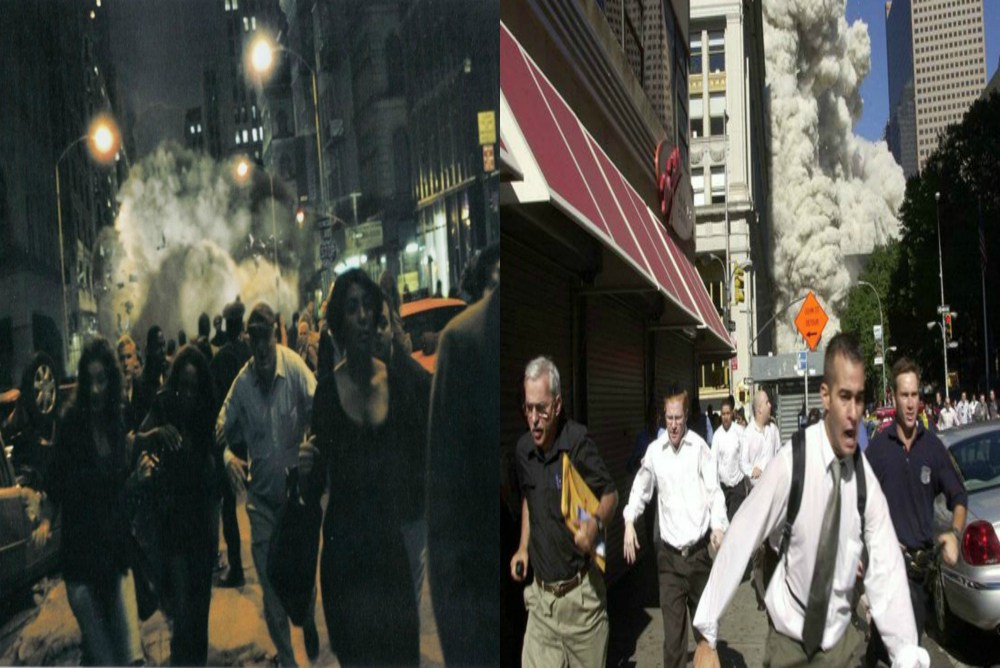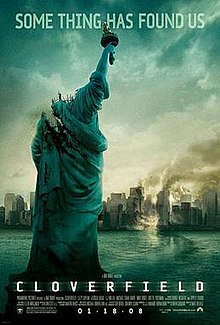Background
Matt Reeves’s Cloverfield (2008) is perhaps best known for its position as a post-9/11 horror film, as well as for its direct references to the 9/11 attacks themselves and to the methods which members of the public and the media recorded the event. It was a major production, helmed and created by J.J. Abrams (who came up with the idea for the monster while in Tokyo on the marketing tour of Mission Impossible III). A viral marketing campaign was used to promote interest in Cloverfield. Each of the characters had MySpace accounts filled with personal updates, messages, and pictures, all maintained by producers of the film. At Comic-Con 2007, shirts for a fictional company named Slusho! were handed out to attendees, along with products from another fictional company Tagruto. Both of these company’s products appear within the film as well.
Critical reception was pretty positive, and many critics noted the film’s awareness and inclusion of the fear of terrorism. It also achieved box office success, grossing $16,930,000 on its opening day in the US and Canada, $40.1 million worldwide on its opening weekend, and a gross of $170,602,318. The film was produced on a budget of $25 million. Despite this success, many movie-goers complained of experiencing motion sickness by watching the film. This reaction was so common that a number of AMC theaters posted signs in the lobby warning customers of the potential “side effects” of watching a film that are similar to those one may experience when “riding a rollercoaster.”

The AMC Cloverfield warning.
Despite these side effects, Cloverfield as spawned a trilogy, including 10 Cloverfield Lane (2016) and The Cloverfield Paradox (2018).
Plot Summary
While attending a good-bye party on May 22, 2009 in Manhattan for Rob Hawkins, who just accepted a job in Japan, Hud Platt films testimonials of all of the party-goers. During the party, we learn that Rob is heartbroken over Beth McIntyre, a former romantic partner of Rob’s who brings a new boyfriend to the party. After the two fight, Beth leaves with her boyfriend. Suddenly, what seems at first to be an earthquake occurs and a power outage sweeps over the city. The party-goers exit the apartment building just in time to see the Statue of Liberty’s head land on the street in front of them. Immediately after this, Hud records what appears to be a giant monster stalking the streets of New York. Hud, Rob, Rob’s brother Jason, Jason’s girlfriend Lily, and Hud’s crush and fellow party-attendee, Marlena, all group together to escape the city until Beth calls Rob to tell him that she is stuck in her apartment and that she can’t move. Rob wants to venture into Midtown Manhattan in order to rescue her, and the rest of the group agrees to go with him so that they leave nobody behind. Jason gets killed by the monster’s tentacle whipping him while on the Brooklyn Bridge (the bridge is also destroyed). The remaining members try to walk through the subway tunnels, but are attacked by a group of miniature monsters. Marlena gets bitten. They escape, but are overtaken by the Army National Guard, who immediately put Marlena into a quarantine zone once they notice that her eyes are bleeding. Her head appears to explode the moment she is placed in quarantine. One of the military leaders lets the group leave in order to find Beth, but he warns them that the last evacuation helicopter will depart soon. After that one leaves, the military plans to destroy Manhattan in order to kill the monster. The three remaining members of the group make it to Beth’s apartment building (which is leaning). She is impaled, but they manage to remove her from the exposed rebar and bandage her wounds. They make it to the evacuation site. Lily gets into a helicopter, but there isn’t room for anyone else, so the remaining three wait for the next one. Once on the second helicopter, the three begin to relax, but then the monster hits the helicopter, causing it to crash near Central Park. The helicopter radio receives a message that the military will destroy Manhattan in fifteen minutes. The three friends begin to run, but Hud is killed by the monster. Rob and Beth hide under a bridge in the park and say their final words into the camera. The bombing starts, the two proclaim their love for each other, then the camera shuts off.
Notes & Quotes
- I’m interested in the role that the military plays in this film. I instantly found myself thinking of Giroux’s The Terror of Neoliberalism because in this text, Giroux posits that a lot of post-9/11 popular culture heavily involves the military. This prominence of the military allows them to gain superhero status, increases registration, and normalizes war. In Cloverfield, the military plays an ambiguous role. When the group of friends is first caught by the military after their foray into the subway tunnels, they are forcibly taken to an impromptu military base and are not allowed to leave. This does seem wise (I would definitely just immediately get into a helicopter and/or ushered out of the city), however, the film presents Rob and his friends’ quest to rescue Beth as a hopeful and remaining glimmer of humanity and normalcy in the face of a terrifying attack on the city. When Marlena shows signs of being bit, there is no comfort or explanation provided, she is brutally grabbed and dragged away by military personal, causing her to die alone, screaming in terror and confusion. The group of friends are repeatedly made to loose their freedoms- particularly the freedom of movement- in return for a (fragile) promise of safety and security. The military is all logic, no feeling- except for the one military leader who allows the group to leave. Finally, the two remaining characters- Beth and Rob- die only because of the military’s decision to bomb all of Manhattan.
- The “we need to flee the city” narrative is a common one in horror films, especially within the apocalyptic and monster subgenres, however, I think this film’s proximity and representation of terrorism allows this narrative to take on an added layer of meaning. Much like Night of the Living Dead’s representation of urban outsiders bunkering down in a suburban farmhouse during a massive zombie attack, Cloverfield also depicts the city as a potentially dangerous place. In the 50s and 60s, the threat was primarily from nuclear or atomic warfare, but in the 2000’s that threat had changed to terrorist attacks. Almost from the moment that the monster is discovered, the terrified people crowding the street outside of Rob’s apartment all head towards the Brooklyn Bridge in an attempt to get out of the city. In fact, the decision to flee the city is not even a decision, what the characters instead discuss and fret over is how to best leave the city. Another prevalent fear in the film is whether or not to trust government agencies. There were a ton of conspiracy theories following the September 11th attack, many of which blamed the government for what happened. On top of these conspiracy theories, there were more logical arguments which questioned whether or not the government did all that it could to prevent such an attack. In Cloverfield, Hud prattles on about the possibility that the monsters were created by the military and accidentally let loose on the city. When his friends tell him to stop talking, he says “It matters because I need to talk about something. Otherwise I’m actually probably going to shit my pants in this stairwell.”
- Of course, there are a number of images in Cloverfield that are immediately reminiscent of 9/11 media and civilian footage. The image that most struck me was the moment that we see a group of people running down a street, away from a big cloud of ash and rubble.

Characters running in Cloverfield (L); People running on 9/11 (R); Image from Horrorhomeroom.com
Also, the choice to make this film found footage (or cinéma verité) was a smart and purposeful one- it allows the resemblance to 9/11 to be even stronger. Anyone who watched the news that day or the weeks that followed can remember how all of the footage deeply resembled the found footage horror film: everything was shaky, sometimes it cut off suddenly, you heard people screaming in the background, and so on. I wonder exactly how beneficial or detrimental this level of connection is between Cloverfield and the 9/11. Does this film have therapeutic value? Is it traumatizing? Or is it just a dumb monster movie? I don’t think it’s the last one.

